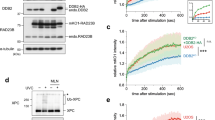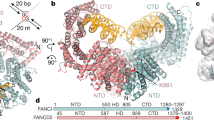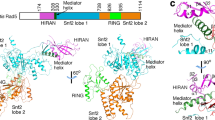Abstract
Rad23 is an evolutionarily conserved protein that is important for nucleotide excision repair1,2,3. A regulatory role has been proposed for Rad23 because rad23 mutants are sensitive to ultraviolet light but are still capable of incising damaged DNA4,5. Here we show that Rad23 interacts with the 26S proteasome through an amino-terminal ubiquitin-like domain (UbLR23). The carboxy terminus of Rad23 binds to the Rad4 DNA repair protein and creates a link between the DNA repair and proteasome pathways. The ultraviolet sensitivity caused by deletion of the UbLR23 domain may therefore arise from its inability to interact with the proteasome. The fusion proteins glutathione S-transferase (GST)–Rad23 and Rad4–haemagglutinin (HA), and the proteasome subunits Cim3 and Cim5, cofractionate through consecutive chromatography steps. The ubiquitin-like domain of human Rad23 (UbLHRB) also interacts with the human proteasome. These results demonstrate that ubiquitin-like domains (UbLs) represent a new class of proteasome-interacting motifs.
This is a preview of subscription content, access via your institution
Access options
Subscribe to this journal
Receive 51 print issues and online access
$199.00 per year
only $3.90 per issue
Buy this article
- Purchase on Springer Link
- Instant access to full article PDF
Prices may be subject to local taxes which are calculated during checkout






Similar content being viewed by others
References
Watkins, J. F., Sung, P., Prakash, L. & Prakash, S. The Saccharomyces cerevisiae DNA repair gene RAD23 encodes a nuclear protein containing a ubiquitin-like domain required for biological function. Mol. Cell. Biol. 13, 7757–7765 (1993).
Masutani, C. et al. Purification and cloning of a nucleotide excision repair complex involving the xeroderma pigmentosum group C protein and a human homologue of yeast RAD23. EMBO J. 13, 1831–1843 (1994).
van der Spek, P. J. et al. XPC and human homologs of RAD23: intracellular localization and relationship to other nucleotide excision repair complexes. Nucleic Acids Res. 24, 2551–2559 (1996).
Miller, R. D., Prakash, L. & Prakash, S. Defective excision of pyrimidine dimers and interstrand crosslinks in rad7 and rad23 mutants of Saccharomyces cerevisiae. Mol. Gen. Genet. 188, 235–239 (1982).
Guzder, S. M., Bailly, V., Sung, P., Prakash, L. & Prakash, S. Yeast DNA repair protein RAD23 promotes complex formation between transcription factor TFIIH and DNA damage recognition factor RAD14. J. Biol. Chem. 270, 8385–8388 (1995).
Madura, K. & Varshavsky, A. Degradation of Gα by the N-end rule pathway. Science 265, 1454–1458 (1994).
Ghislain, M., Udvardy, A. & Mann, C. Saccharomyces cerevisiae 26S protease mutants arrest cell division in G2/metaphase. Nature 366, 358–361 (1993).
Coux, O., Tanaka, K. & Goldberg, A. L. Structure and functions of the 20S and 26S proteasomes. Annu. Rev. Biochem. 65, 801–847 (1996).
Garrett, K. P. et al. Positive regulation of general transcription factor SIII by a tailed ubiquitin homolog. Proc. Natl Acad. Sci. USA 92, 7172–7176 (1995).
Guzder, S. N., Habraken, Y., Sung, P., Prakash, L. & Prakash, S. Reconstitution of yeast nucleotide excision repair with purified Rad proteins, Replication Protein A, and transcription factor TFIIH. J. Biol. Chem. 270, 12973–12976 (1995).
Wang, Z. et al. The RAD7, RAD16 and RAD23 genes of Saccharomyces cerevisiae: Requirements for transcription-independent nucleotide excision repair in vitro and interactions between the gene products. Mol. Cell. Biol. 17, 635–643 (1997).
Rubin, D. M. et al. Identification of the gal4 suppressor Sug1 as a subunit of the yeast 26S proteasome. Nature 370, 655–657 (1996).
Hicke, L. & Riezman, H. Ubiquitination of a yeast plasma membrane receptor signals its ligand-stimulated endocytosis. Cell 84, 277–287 (1996).
Mu, D., Hsu, D. S. & Sancar, A. Reaction mechanism of human DNA repair excision nuclease. J. Biol. Chem. 271, 8285–8294 (1996).
Sugasawa, K. et al. HHR23B, a human Rad23 homolog, stimulates XPC protein in nucleotide excision repair in vitro. Mol. Cell. Biol. 16, 4852–4861 (1996).
Reardon, J. T., Mu, T. & Sancar, A. Overproduction, purification, and characterization of the XPC subunit of the human DNA repair excision nuclease. J. Biol. Chem. 271, 19451–19456 (1996).
McCready, S. Repair of 6-4 photoproducts and cyclobutane pyrimidine dimers in rad mutants of Saccharomyces cerevisiae. Mutat. Res. 315, 261–273 (1994).
Verhage, R. A., Seeman, A.-M., Lombaerts, M., van de Putte, P. & Brouwer, J. Analysis of gene- and strand-specific repair in the moderately UV-sensitive Saccharomyces cerevisiae rad23 mutant. Mutat. Res. 362, 155–165 (1996).
Mueller, J. P. & Smerdon, M. J. Rad23 is required for transcription-coupled repair and efficient overall repair in Saccharomyces cerevisiae. Mol. Cell. Biol. 16, 2361–2368 (1996).
Baniahmad, C., Baniahmad, A. & O'Malley, B. W. Arapid method combining a functional test of fusion proteins in vivo and their purification. BioTechniques 16, 194–196 (1994).
Chen, P., Johnson, P., Sommer, T., Jentsch, S. & Hochstrasser, M. Multiple ubiquitin-conjugating enzymes participate in the in vivo degradation of the yeast MATα2 repressor. Cell 74, 357–369 (1993).
Heinemeyer, W., Kleinschmidt, J. A., Saidowsky, J., Escher, C. & Wolf, D. H. Proteinase YSCE, the yeast proteasome/multicatalytic-multifunctional proteinase-mutants unravel its function in stress-induced proteolysis and uncover its necessity for cell-survival. EMBO. J. 10, 555–562 (1991).
Merrick, W. C. Assays for eukaryotic protein synthesis. Methods Enzymol. 60, 108–123 (1979).
Acknowledgements
We thank C. Mann for antisera against Cim3/Sug1 and Cim5, M. Ghislain for cim3-1 and cim5-1 strains; J. Dohmen for the plasmid expressing Pre1-Flag; J. H. Hoeijmakers for cDNA clones expressing HHR23-A and HHR23-B; and D. Reinberg for HeLa cell extracts. This work was supported by a grant from the NIH (K.M.). I.V. was supported by a pre-doctoral fellowship from the NIH.
Author information
Authors and Affiliations
Corresponding author
Rights and permissions
About this article
Cite this article
Schauber, C., Chen, L., Tongaonkar, P. et al. Rad23 links DNA repair to the ubiquitin/proteasome pathway. Nature 391, 715–718 (1998). https://doi.org/10.1038/35661
Received:
Accepted:
Issue Date:
DOI: https://doi.org/10.1038/35661
This article is cited by
-
Lysine deserts prevent adventitious ubiquitylation of ubiquitin-proteasome components
Cellular and Molecular Life Sciences (2023)
-
Structure of HIV-1 Vpr in complex with the human nucleotide excision repair protein hHR23A
Nature Communications (2021)
-
Transcriptomic Analysis of Pacific Oyster (Crassostrea gigas) Zygotes Under Hypotonic Triploid Induction
Journal of Ocean University of China (2021)
-
SerpinB2 is involved in cellular response upon UV irradiation
Scientific Reports (2019)
-
The UbL-UBA Ubiquilin4 protein functions as a tumor suppressor in gastric cancer by p53-dependent and p53-independent regulation of p21
Cell Death & Differentiation (2019)
Comments
By submitting a comment you agree to abide by our Terms and Community Guidelines. If you find something abusive or that does not comply with our terms or guidelines please flag it as inappropriate.



